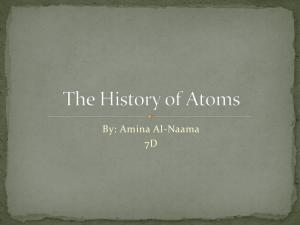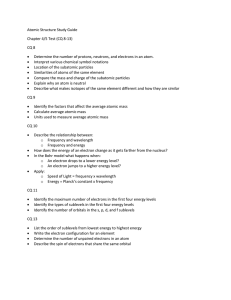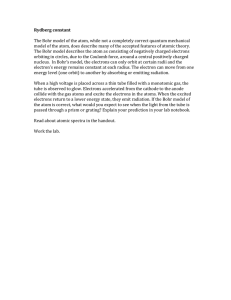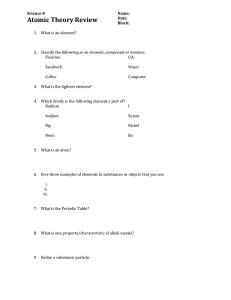Atomic Structure – Subatomic Particles
advertisement
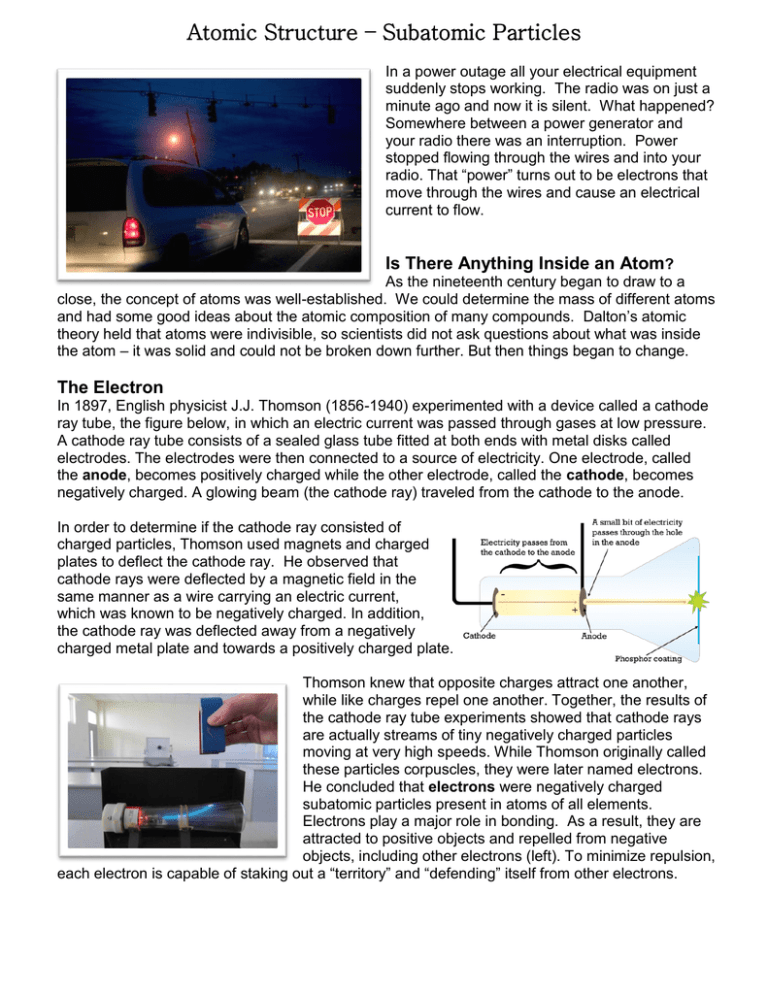
Atomic Structure – Subatomic Particles In a power outage all your electrical equipment suddenly stops working. The radio was on just a minute ago and now it is silent. What happened? Somewhere between a power generator and your radio there was an interruption. Power stopped flowing through the wires and into your radio. That “power” turns out to be electrons that move through the wires and cause an electrical current to flow. Is There Anything Inside an Atom? As the nineteenth century began to draw to a close, the concept of atoms was well-established. We could determine the mass of different atoms and had some good ideas about the atomic composition of many compounds. Dalton’s atomic theory held that atoms were indivisible, so scientists did not ask questions about what was inside the atom – it was solid and could not be broken down further. But then things began to change. The Electron In 1897, English physicist J.J. Thomson (1856-1940) experimented with a device called a cathode ray tube, the figure below, in which an electric current was passed through gases at low pressure. A cathode ray tube consists of a sealed glass tube fitted at both ends with metal disks called electrodes. The electrodes were then connected to a source of electricity. One electrode, called the anode, becomes positively charged while the other electrode, called the cathode, becomes negatively charged. A glowing beam (the cathode ray) traveled from the cathode to the anode. In order to determine if the cathode ray consisted of charged particles, Thomson used magnets and charged plates to deflect the cathode ray. He observed that cathode rays were deflected by a magnetic field in the same manner as a wire carrying an electric current, which was known to be negatively charged. In addition, the cathode ray was deflected away from a negatively charged metal plate and towards a positively charged plate. Thomson knew that opposite charges attract one another, while like charges repel one another. Together, the results of the cathode ray tube experiments showed that cathode rays are actually streams of tiny negatively charged particles moving at very high speeds. While Thomson originally called these particles corpuscles, they were later named electrons. He concluded that electrons were negatively charged subatomic particles present in atoms of all elements. Electrons play a major role in bonding. As a result, they are attracted to positive objects and repelled from negative objects, including other electrons (left). To minimize repulsion, each electron is capable of staking out a “territory” and “defending” itself from other electrons. Atomic Structure – Subatomic Particles Protons Describing what we can see is a fairly easy matter. If we are asked to describe the sports car illustrated above, we could all quickly come up with a fairly accurate description. A person knowledgeable about cars would include more details, but everyone would have the basic information in their description. What makes the description easy to come up with? We can see it, we have a common language to describe it (size, color, construction), and we have a basic idea of what it is (a car, not a house or a tree). Scientists have far more difficulty in describing things they cannot see. There is no way to look directly at an atom to see its detailed structure. When we first make a discovery, there is often no language to use to tell others exactly what it is. This was the problem in talking about the atom and its make-up. Putting the Puzzle Pieces Together Research builds upon itself – one piece connects to another. Sometimes the puzzle doesn’t seem to make sense because some of the pieces are missing at the moment. Each finding gives a clearer picture of the whole and also raises new questions. The detective work that led to the discovery of the proton was built upon finding pieces to the puzzle and putting them together in the right way. The electron was discovered using a cathode ray tube. An electric current was passed from the cathode (the negative pole) to the anode (positive pole). Several experiments showed that particles were emitted at the cathode and that these particles had a negative charge. These experiments demonstrated the presence of electrons. If cathode rays are electrons that are given off by the metal atoms of the cathode, then what remains of the atoms that have lost those electrons? We know several basic things about electrical charges. They are carried by particles of matter and exist as whole-number multiples of a single basic unit. Atoms have no overall electrical charge, meaning that each and every atom contains an exactly equal number of positively and negatively charged particles. A hydrogen atom is the simplest kind of atom with only one electron. When that electron is removed, a positively charged particle should remain. Discovery of the Proton In 1886 Eugene Goldstein (1850-1930) discovered evidence for the existence of this positively charged particle. Using a cathode ray tube with holes in the cathode, he noticed that there were rays traveling in the opposite direction from the cathode rays. He called these canal rays and showed that they were composed of positively charged particles. The proton is the positively charged subatomic particle present in all atoms, so they are attracted to negative objects and repelled from positive objects. Again, this means that protons repel each other (illustrated below). However, unlike electrons, protons are forced to group together into one big clump, even though they repel each other. Protons are bound together by what are termed strong nuclear forces. These forces are responsible for binding the atomic nuclei together, allowing the protons to form a dense, positively charged center. Atomic Structure – Subatomic Particles The Nucleus The way Rutherford discovered the atomic nucleus is a good example of the role of creativity in science. His quest actually began in 1899 when he discovered that some elements give off positively charged particles that can penetrate just about anything. He called these particles alpha (α) particles (we now know they were helium nuclei). Like all good scientists, Rutherford was curious. He wondered how he could use alpha particles to learn about the structure of the atom. He decided to aim a beam of alpha particles at a sheet of very thin gold foil. He chose gold because it can be pounded into sheets that are only 0.00004 cm thick. Surrounding the sheet of gold foil, he placed a screen that glowed when alpha particles struck it. It would be used to detect the alpha particles after they passed through the foil. A small slit in the screen allowed the beam of alpha particles to reach the foil from the particle emitter. You can see the setup for Rutherford’s experiment in the figure below. Assuming a plum pudding model of the atom, Rutherford predicted that the areas of positive charge in the gold atoms would deflect, or bend, the path of all the alpha particles as they passed through. You can see what really happened in the figure above. Most of the alpha particles passed straight through the gold foil as though it wasn’t there. The particles seemed to be passing through empty space. Only a few of the alpha particles were deflected from their straight path, as Rutherford had predicted. Surprisingly, a tiny percentage of the particles bounced back from the foil like a basketball bouncing off a backboard! The Nucleus Takes Center Stage Rutherford made the same inferences. He concluded that all of the positive charge and virtually all of the mass of an atom are concentrated in one tiny area and the rest of the atom is mostly empty space. Rutherford called the area of concentrated positive charge the nucleus. He predicted—and soon discovered—that the nucleus contains positively charged particles, which he named protons. Rutherford also predicted the existence of neutral nuclear particles called neutrons, but he failed to find them. However, his student James Chadwick discovered them several years later. Atomic Structure – Subatomic Particles Neutrons The most famous detective in literature and history never existed. Sherlock Holmes was the creation of the British author Sir Arthur Conan Doyle. This mythical person had capabilities far beyond those of mere mortals. Holmes was capable of spotting the tiniest clue, the smallest piece of evidence to solve the crime. He could link all sorts of seemingly irrelevant data into a coherent whole to clear up whatever mystery he was dealing with. The Quest for the Neutron Clues are generally considered to involve the presence of something – a footprint, a piece of fabric, a bloodstain, something tangible that we can measure directly. The discoveries of the electron and the proton were accomplished by those kinds of clues. Cathode ray tube experiments showed both the electrons emitted by the cathode with their negative charge that could be measured and the proton (also emitted by the cathode) with its positive charge. The neutron initially was found not by a direct observation, but by noting what was not found. Research had shown the properties of the electron and the proton. Scientists learned that approximately 1837 electrons weighted the same as one proton. There was evidence to suggest that electrons went around the heavy nucleus composed of protons. Charge was balanced with equal numbers of electrons and protons making up an electrically neutral atom. But there was a problem with this model – the atomic number (number of protons) did not match the atomic weight. In fact, the atomic number was usually about half the atomic weight. Therefore, something else must be present. That something must weigh about the same as a proton, but could not have a charge – this new particle had to be electrically neutral. In 1920 Ernest Rutherford tried to explain this phenomenon. Rutherford proposed the existence of a neutral particle along with the approximate mass of a proton, but it wasn't until years later that someone proved the existence of the neutron. A physicist named James Chadwick observed that when beryllium was bombarded with alpha particles, it emitted an unknown radiation that had approximately the same mass as a proton, but the radiation had no electrical charge. Chadwick was able to prove that these beryllium emissions contained a neutral particle – Rutherford’s neutron. This became known as the third subatomic particle or the neutron. As you might have already guessed from its name, the neutron is neutral. In other words, it has no charge and is therefore neither attracted to nor repelled from other objects. Neutrons are in every atom (with one exception), and they’re bound together with other neutrons and protons in the atomic nucleus. Again, the binding forces that help to keep neutrons fastened into the nucleus are known as strong nuclear forces. Since neutrons are neither attracted to nor repelled from objects, they don’t interact with protons or electrons beyond being bound into the nucleus with the protons. Protons and electrons, however, do interact. Using what you know about protons and electrons, what do you think will happen when an electron approaches a proton? Will the two subatomic particles be attracted to each other or repelled from each other? Here’s a hint: “opposites attract, likes repel.” Since electrons and protons have opposite charges (one negative, the other positive), you’d expect them to be attracted to each other, as illustrated below. Atomic Structure – Subatomic Particles Bohr Model of the Atom By 1913, our concept of the atom had evolved from Dalton’s idea of indivisible spheres to Thomson’s plum-pudding model and then to Rutherford’s nuclear atom theory, figure below. Rutherford, in addition to carrying out the experiment that demonstrated the presence of the atomic nucleus, proposed that the electrons circled the nucleus in a planetary-like motion. The planetary model of the atom was attractive to scientists because it was similar to something with which they were already familiar, namely the solar system. Unfortunately, there was a serious flaw in the planetary model. At that time, it was already known that when a charged particle moves in a curved path, the particle emits some form of light or radio waves and loses energy in doing so. If the electron circling the nucleus in an atom loses energy, it would necessarily have to move closer to the nucleus (because of the loss of potential energy) and would eventually crash into the nucleus. Scientists, however, saw no evidence that electrons were constantly emitting energy or crashing into the nucleus. These difficulties cast a shadow on the planetary model and indicated that it would eventually be replaced. The replacement model came in 1913 when the Danish physicist Niels Bohr proposed an electron cloud model where the electrons orbit the nucleus but did not have to lose energy. Bohr’s Energy Levels The key idea in the Bohr model of the atom is that electrons occupy definite orbits that require the electron to have a specific amount of energy. In order for an electron to be in the electron cloud of an atom, it must be in one of the allowable orbits and have the precise energy required for that orbit. Orbits closer to the nucleus would require the electrons to have a smaller amount of energy, and orbits farther from the nucleus would require the electrons to have a greater amount of energy. The possible orbits are known as energy levels. Atomic Structure – Subatomic Particles Bohr hypothesized that the only way electrons could gain or lose energy would be to move from one energy level to another, thus gaining or losing precise amounts of energy. It would be like a ladder that had rungs at certain heights. The only way you can be on that ladder is to be on one of the rungs, and the only way you could move up or down is to move to one of the other rungs. Other rules for the ladder are that only one person can be on a given rung and that the ladder occupants must be on the lowest rung available. Suppose we had such a ladder with 10 rungs. If the ladder had five people on it, they would be on the lowest five rungs. In this situation, no person could move down because all the lower rungs are full. Bohr worked out the rules for the maximum number of electrons that could be in each energy level in his model. In its normal state (ground state), this would require the atom to have all of its electrons in the lowest energy levels available. Under these circumstances, no electron could lose energy because no electron could move down to a lower energy level. In this way, the Bohr model explained why electrons circling the nucleus did not emit energy and spiral into the nucleus. Bohr Model and Atomic Spectra The evidence used to support the Bohr model came from the atomic spectra. Bohr suggested that an atomic spectrum is created when the electrons in an atom move between energy levels. The electrons typically have the lowest energy possible, but upon absorbing energy, the electrons would jump to a higher energy level, producing an excited and unstable state. The electrons would then immediately fall back to a lower energy level and re-emit the absorbed energy. The energy emitted during these electron “step downs” would be emitted as light and would correspond with a specific line in the atomic emission spectrum. Bohr was able to mathematically produce a set of energy levels for the hydrogen atom. In his calculations, the differences between the energy levels were the exact same energies of the frequencies of light emitted in the hydrogen spectrum. One of the most convincing aspects of the Bohr model was that it predicted that the hydrogen atom would emit some electromagnetic radiation outside the visible range. When scientists looked for these emissions in the infrared region, they were able to find them at the exact frequencies predicted by the Bohr model. Bohr's theory was rapidly accepted and he received the Nobel Prize for physics in 1922. Shortcomings of the Bohr Model The development of the Bohr model is a good example of applying the scientific method. It shows how the observations of the atomic spectra led to the creation of a hypothesis about the nature of electron clouds. The hypothesis also made predictions about emissions that had not yet been observed (the infrared light emissions). Predicted observations such as these provide an opportunity to test the hypothesis through experimentation. When these predictions were found to be correct, they provided evidence in support of the theory. Of course, further observations can also provide insupportable evidence that will cause the theory to be rejected or modified. In the case of the Bohr model of the atom, it was determined that the energy levels in atoms with more than one electron could not be successfully calculated. Bohr’s system was only successful for atoms that have a single electron, which meant that the Bohr model did not accurately reflect the behaviors of most atoms. Another problem with Bohr's theory was that the Bohr model did not explain why certain energy levels existed. As mentioned earlier in this lesson, at the time it was already known that charged particles emit some form of light or radio waves when moving in a curved path. Scientists have used this principle to create radio signals since 1895. This was the serious flaw in Rutherford's planetary model of the atom, which Bohr attempted to deal with by suggesting his electron cloud model. Although his calculated energy levels for the hydrogen were Atomic Structure – Subatomic Particles supported by hydrogen's emission spectrum, Bohr did not, however, explain why only the exact energy levels he calculated were present. Yet another problem with the Bohr model was the predicted positions of the electrons in the electron cloud. If Bohr's model were correct, the electron in the hydrogen atom in ground state would always be the same distance from the nucleus. Although the actual path that the electron followed could not be determined, scientists were able to determine the positions of the electron at various times. If the electron circled the nucleus as suggested by the Bohr model, the electron positions would always be the same distance from the nucleus. In reality, the electron is found at many different distances from the nucleus. In the figure above, the left side of the image (labeled as A) shows the random positions an electron would occupy as predicted by the Bohr model, while the right side (labeled as B) shows some actual positions of an electron. The Bohr model was not, however, a complete failure. It provided valuable insights that triggered the next step in the development of the modern concept of the atom. Resources Video: History of Atomic Chemistry https://www.youtube.com/watch?v=thnDxFdkzZs
